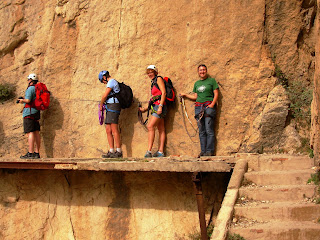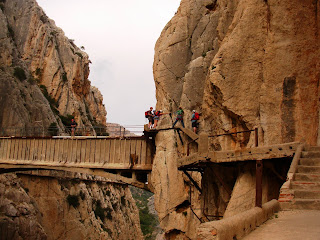My two-month mark appears tomorrow! Now that I’m truly settled in and have my routine, it’s about time that I write about what I’m actually doing here in Spain: teaching.
I work in a secondary school (ages 11-18) in the town of Santanyí, which is the town that I live in, and I also work in an elementary school (ages 3-11) in the town of S’Alqueria Blanca, about 4K away. My schedule currently has me working two days a week in the elementary school and one day a week in the high school. Now you can see why I keep writing about my leisure time—I’ve got a lot of it! I’ll try to dedicate this post solely to the work aspect of this year abroad.
I love teaching. Unfortunately, I’m not actually teaching. I’m the teaching assistant, which means that in some classes I’m just an English-speaking mouth with a person attached, but in others I get to lead class and come up with activities and fun things to do. Also unfortunately, the English level is so low that I don’t feel like I’m getting very far with the kids.
The English I teach here is in no way conversational English. Imagine your high school Spanish class: no matter how advanced it was, could you ever have a discussion on the differences between North American and Latin American culture? Could you even have a decent conversation on the weather, or your health—the two most frequent and therefore among the most important conversations to master early on? I know I certainly couldn’t. The English in the schools here isn’t much more advanced than that.
In every class, I introduce myself, talk a little bit about where I come from, and open it up for questions. Usually (obviously) the kids have no questions until I remind them that unless they have questions, we’ll just have to go to the textbook and have class as usual. After miming out most of the sentence, the kids get the idea, and some of the weirdest questions come out. The “do you like” construction is very popular: (“Do you like babies?” “Do you like Avenged Sevenfold?”) Sometimes the kids branch out a bit: one kid came up with some very creative questions. “Why America conduction left?” and “How time where you?” were two of his more interesting queries.
Spanish-speakers: think about those for a bit. Conduction…conducción…conducir! (By the way: in Spain you definitely do not manejar un carro; you conducir un coche). So, with a bit of linguistic and geographical wizardry, the first question morphs into: “Why do they drive on the left-hand side of the road in England?” (the kids still can’t quite figure out that England and America are very different countries.) For the second question, just translate it directly back into Spanish: “How time… where you?” turns into “Cómo tiempo donde ti?” which obviously means “What’s the weather like where you live?”
A few other riddles for you: what do you think the common commands, “Stuff your chair!” and “Keep your rubber!” mean? These are two phrases the teachers often employ.
The first one can also be elongated as, “Stuff your chair under your table!” (need another hint? “table” is the word for “desk,” and the kids are told this when they all jump up like cooped-up monsters when it’s finally time for recess.)
For the second one, well… “rubbers,” of course, are perfectly innocuous, small items that every kid carries in his pocket. Quit thinking dirty thoughts—we’re talking about erasers! That’s perfectly British English, I guess. However, the verb “keep” usually is used to mean “put away,” which I’m pretty sure isn’t English from any English-speaking country. The longer version of the second command might be “Keep your rubber in your pencil case,” and the teachers usually say that when the kids start using their “rubbers” as ersatz bouncy-balls.
The kids are learning very weird English—or they’re learning English a very weird way. For example, for a recent lesson they had to repeat a dialogue, then act out the dialogue, then make a book by cutting out pre-made pictures with captions containing the dialogue, which goes like this:
Narrator: Texas Tom is sad.
Texas Tom: I don’t like horse riding. I’m not a real cowboy.
Sue Ellen: Come on, Tom, horse riding is fun!
Texas Tom: I don’t like horse riding.
Sue Ellen: Come on, Tom, horse riding is fun!
Narrator: Texas Tom rides Silver.
Texas Tom: OK. Wow, horse riding is fun!
Sue Ellen: Now you’re a real cowboy!
Then again, I remember dialogues from high school Spanish class that were also quite strange. For example, in one sentence, Paco says something like, “Mis pantalones están sucios. Voy a comprar nuevos pantalones.” (My pants are dirty. I’m going to buy new pants.) I suppose second-language learning never is real. Even while speaking in a second language, I somehow feel not-quite real. Lots of people say they have different personalities when speaking in different languages, but until I feel like I at least have some personality in Spanish, I’ll always wince when someone asks me if I’m fluent.
Whoa, that’s a completely different topic! Sorry, every day of teaching in English is another day that teaches me how much I have to learn! I need to learn more Spanish, and I really need to learn Mallorquín, or else I’m never going to progress socially. I’m just as stunted in my Mallorquín as these kids are in their English (I’ve whipped out a few phrases in Mallorquín, and I’m sure they sounded just like “How time?” to native speakers) and I understand their frustrations. I’m trying to be patient and to explain everything as clearly as I possibly can—the only thing that I can’t stand is when the kids are obviously not motivated. English is a required class from 4 years old until university graduation, and most kids hate it. I’m trying to come up with activities to make English seem like fun (see my previous post to see the Thanksgiving video that my friends made that I showed in all my classes—we discussed that video and talked about common foods and family traditions) and, poc a poc, we’re getting there.
Throughout this year, I’ll grow as a teacher, and I’ll keep trying to help the kids express themselves in English. This has been an awesome experience so far, and I’m excited to be here, teaching, for five more months!
***
PS: here are a few useful words and phrases that I've picked up since being here (1st word is in Spanish, 2nd is in Catalan)
ahora / ara : presently, sometime soon, within the next hour or so. When the teachers ask me, "Jeni, ¿véns ara?" they definitely don't mean "Jennifer, are you coming right now?" The first couple times the teachers have said this, I hopped up and said "yes, I'm coming now," and each time the teachers have said, "No, Jeni, tranquila. Ahora vamos," ("No, Jennifer, calm down. We'll leave ahora..." which means, more or less, "sometime soon.")
venga : come on, OK, goodbye. "Venga," as any student learning Spanish knows, is the formal command form or subjunctive form of "venir." In Latin America, the "usted" (formal) form is used quite often, and so you'll often here, "venga" to mean "You (formal) come here." In Spain, I've hardly ever heard anyone use "usted", and when I do, I'm always corrected. However, the word "venga" is used all the time. The most common form of "venga" is "Come on!" When the kids start making noise or quit paying attention or start playing with their neighbors, the teachers always shout, "Jesús, ¡venga!" or "Díaz, ¡venga!" "Venga" can also mean "OK," such as, "Jeni, ¿véns amb mi ara? venga, anem," (Jeni, are you coming with me sometime in the near future? OK, let's go,) But it is also used at the end of conversations to mean "Hey, I want to get off the phone now," such as the following telephone conversation I overheard: "OK, nos vemos a las dos, venga, hasta ahora," (OK, see you at two, goodbye, see you very shortly). I hear people use this word also when speaking in Mallorquín, but I'm not sure if it's spelled differently.
enhorabuena / enhorabona : Congratulations! I thought this meant "about time," because if you break it apart, it turns into "en hora buena" or "in good time", but people say it when somebody has a baby, or does something good at work, or at the beginning of the Thanksgiving potluck that I organized on Tuesday.
molt d'anys : Congratulations! Cheers! Happy Birthday! This literally means "many years" in Catalan, and people say it at the beginning of special meals, such as the Thanksgiving potluck I organized on Tuesday, and it's also the most common way to say "happy birthday".
















































